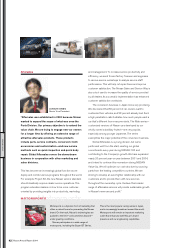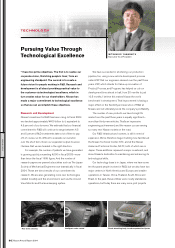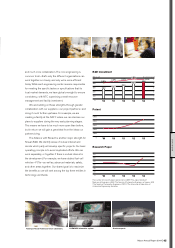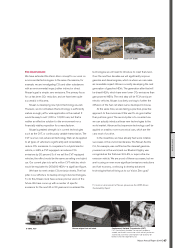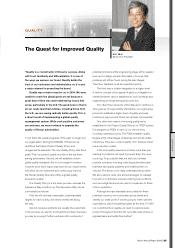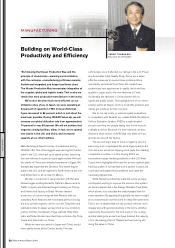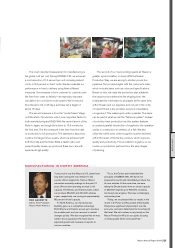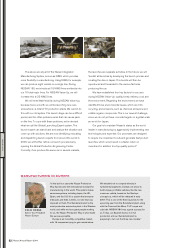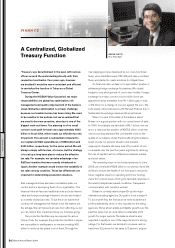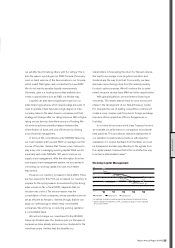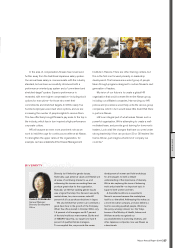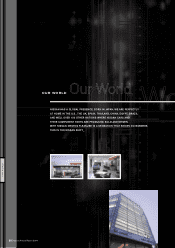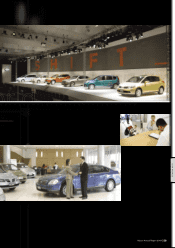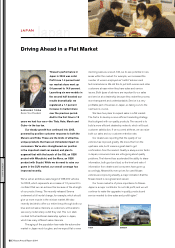Nissan 2005 Annual Report Download - page 53
Download and view the complete annual report
Please find page 53 of the 2005 Nissan annual report below. You can navigate through the pages in the report by either clicking on the pages listed below, or by using the keyword search tool below to find specific information within the annual report.
Nissan Annual Report 2004 51
“I am proud to say that Nissan’s U.S. plants have
long been among the most efficient in the
country. We’ve topped the Harbour Report
automotive assembly rankings for the past 12
years. We are now operating at close to full
capacity. The Smyrna and Canton plants, which
can produce 550,000 and 400,000 vehicles
a year, respectively, are running at approximately
85 percent of total capacity.
“In North America, our manufacturing
flexibility gives us a competitive advantage.
Both Smyrna and Canton are set up to produce
five models each, and we can react to market
changes quickly. We also recognize that we may
need to boost capacity in the future due to
expected growth and increases in exports to
various countries.
“To us, the Canton plant embodied the
principles of NISSAN 180. We had to be
prepared to launch and immediately produce five
all-new vehicles. At the same time, we were
taking the Decherd plant from an annual capacity
of 250,000 engines up to 950,000, including
two brand-new engines. That was a challenging
and exciting time.
“Today, we are pleased that our results in the
recent J. D. Power and Associates Initial Quality
Study show significant improvement over the
prior year, and we’re determined to move beyond
that level. We will continue to rely heavily on the
Nissan Production Way as our guide, focusing
on being quality-driven and waste-free.”
DAN GAUDETTE
Senior Vice President
Nissan North America
NNoorrtthh AAmmeerriiccaa
MANUFACTURING IN NORTH AMERICA
OUR WORK
The most important measurement in manufacturing is
the global cost per unit. During NISSAN 180, we achieved
a cost reduction of 14 percent per unit, including indirect
costs, or 8.3 percent in direct costs. We also evaluate our
performance in time to delivery using three different
measures. One measure is from customer to customer, and
the time from order to delivery—an especially important
calculation for our build-to-order system. We’ve reduced
this interval to 24 or 25 days, and have set a target of
about 18 days.
The second measure is from the “model freeze” stage
until the start of production, which is an important factor for
both manufacturing and R&D. With the recent launch of the
Note in Japan, we brought this down to 10.5 months for
the first time. The third measure is the time from the start
of production to full production. The standard is about two
months. Our target is two weeks, which we achieved with
both the Tiida and the Note. While a faster rate could
present quality issues, we produced these two cars with
speed and high quality.
The second of our ‘never-ending’ quests at Nissan is
greater synchronization, or douki. With the Nissan
Production Way, we are aiming to shorten production
pipelines. The process begins with the customer’s order,
which includes items such as colors and specifications.
Based on this, we make the production plan, establish
the sequence and determine the shipping time. We
broadcast this information to all players at the same time,
within Nissan and our suppliers, and not just in the order
of need. If there is any problem, everyone immediately
recognizes it. This makes quick action possible. The same
can be said of what we call the “fishbone system.” Instead
of a strictly linear production line, this system features
a constant, parallel introduction of supplies to the operation
similar in construction to skeleton of a fish. We also
utilize the ‘strike zone,’ where supplies must be delivered
within the reach of the factory workers, which improves
quality and productivity. This is related to logistics, so we
involve our production partners from the early stages
of planning.



